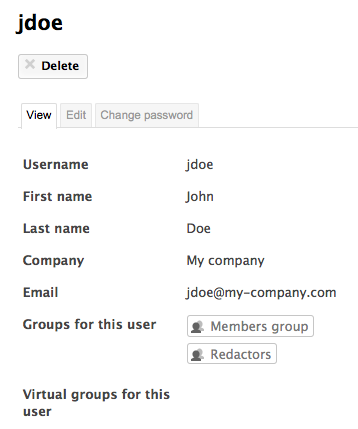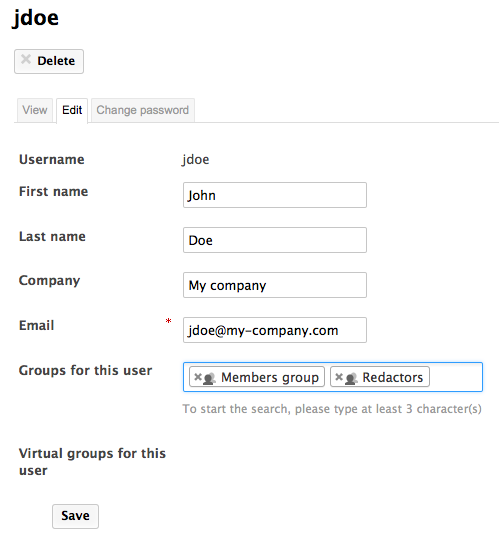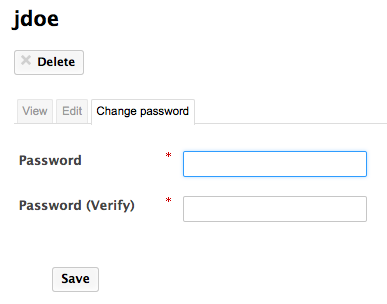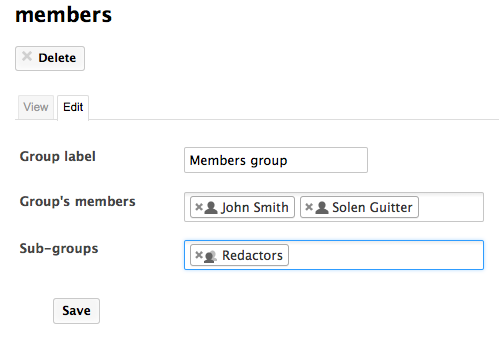Only administrators and power users can manage users and groups. They can create new users and groups, modify their properties or delete them. It is also possible to connect the Platform to an external directory (LDAP directory for instance).
Users can only consult users and groups directories. Administrators and power users can create, edit and delete users and groups.
When you use an external directory for users and groups, the actions available on users and groups are limited, even to administrators.
Users and groups management is available:
- from the Admin Center, in the Users & groups tab,


- from the Home tab, in the Users & groups tab.


Managing Users
User's Parameters
The whole set of information about users consists of the items below:
| Field | Description |
|---|---|
| Username |
The name the user will use to log in. |
| First name |
First name of the user |
| Last name |
Last name of the user |
| Company |
Company or organization of the user |
|
|
email of the user This address is used for alerts. |
| Password | User's password |
| Password (Verify) | User's password |
| Groups for this user |
Groups of which the user is a member. User must be at least in 'administrators' or 'members' group, or one of their sub-groups. |
| Virtual groups for this user | |
| Avatar | Image that represents the user in the application. |
| Birth date | User's birth date |
| Phone number | User's phone number |
| Gender | User's gender. Default value is Male. |
The avatar, birth date, phone number and gender are personal information that can only be set by the user himself. They are not available from the Admin Center Users & Groups user interface.
Creating a User
Only administrators and power users can create new users.
By default, the Nuxeo Platform has one user, called Administrator. This user is the administrator. You must use it to create new users and delegate them access rights.
Users must be at least in "administrators" or "members" group, or one of their sub-groups to be able to browse the application's content.
When you create a new user, you can either create the user account immediately or invite the person to access the Nuxeo Platform.
Inviting a New User
Inviting a new user means creating a user account without setting its password, and having the user validate the invitation.
To invite a user:
- Click on the Admin Center main tab, and then on the Users & groups tab. The members management interface opens on the user directory search form.
- Click on the Create a new user button.
The invitation form is displayed.


- Fill in the user creation form. Mandatory fields are indicated by a red asterisk.
- Click on the Invite button. The user directory search form is displayed. An invitation email is sent to the user at the email address you filled in. The user account is pending the user validation and the user account is not available in the user search results.
To validate the invitation:
- In the invitation email, click on the validation link.
A browser page opens.


- Define your password and click on the Submit button. Your user account is created. You are redirected to the login page of the Nuxeo Platform: you can now log in and use the Platform.
Creating a New User Account
When you create a new user account immediately, you choose and set the user's password.
To create a user:
- Click on the Admin Center main tab, and then on the Users & groups tab. The members management interface opens on the user directory search form.
- Click on the Create a new user button. The invitation form is displayed.
- Check the box Set password for immediate user creation. The complete user creation form with the password creation form is displayed.
Fill in the user creation form. Mandatory fields are indicated by a red asterisk.
Click on the Save button. The card of the new user is displayed. You can modify his properties and his password.
If you need to create several users click on the Save and create button. The user is saved and the user creation form is displayed so you can immediately create another user.
The user can immediately connect to the Nuxeo application using his or her username and password.


Editing a User's Properties
Only administrators and power users can modify other users' properties. But every user can modify his own properties from the Profile tab of his Home.
You cannot edit the username, as it is the ID of the user on the application.


When you are using an external directory for users management, the Edit tab is not displayed as you cannot edit the users' properties (managed directly from the directory).
To modify a user's properties:
- Click on the Admin Center main tab, and then on the Users & groups tab. The members management interface opens on the user directory search form.
- Search a user and click on the user's name to open his or her card. The user's card is displayed.
- Click on the Edit tab.
- Modify the fields in the modification form.
- Click on the Save button. The View tab is displayed with your modifications
Changing a User's Password
Only administrators and power users can modify other users' password. However every user can modify his or her own password from his/her Home > Profile tab.
When you use an external directory for users management, the Change password tab is not displayed as you cannot edit your password.


To modify a user's password:
- Click on the Admin Center main tab, and then on the Users & groups tab. The members management interface opens on the user directory search form.
- Search a user and click on the user's name to open his or her card. The user's card is displayed.
- Click on the Change password tab.
- Type the new password and confirm it.
- Click on the Save button. The View tab is displayed. The user must use his or her new password the next time he or she logs in.
Deleting a User
Only administrators and power users can delete users.
Deleting a user is a permanent action.
To delete a user:
- Click on the Admin Center main tab, and then on the Users & groups tab. The members management interface opens on the user directory search form.
- Search a user and click on the user's name to open his or her card. The user's card is displayed.
- Click on the Delete button. A window pops up.
- Click on the OK button. The user is deleted. He or she cannot log in to the Nuxeo application.
Managing Groups
Groups of users can be created and their properties modified directly in the Nuxeo Platform.
To make access rights management easier, you can create groups of users. Instead of giving (or denying) access rights to single users and repeat the same operations several times, you can give several users the same right in one single manipulation by using a group.
Default groups are:
- members: Users in this group are the end-users users of the application.
- power users: Users in this group are the functional administrators of the application. They have a restricted access to the Admin tab, the administration user interface of the Nuxeo Platform, from which they can manage users and groups and edit the vocabularies.
- administrators: Users in this group are the technical administrators of the application. They have access to all the Admin tab features and are in charge of managing the application. Beside the functional administration features, they can edit the application configuration, install packages on the application, consult the application's statistics, restart the server, etc.
Users must be in one of the groups "members" or "administrators" to be able to access content. Power users must be in both the "power users" and "members" groups.
Groups can be composed of users and of sub-groups. Sub-group's members automatically become members of the parent group. Thus, they are granted all the access rights you give to the group. You can create as many groups as needed.
Groups Parameters
| Field | Description |
|---|---|
|
Group name |
The ID of the group. The ID cannot be modified. |
|
Group label |
The name of the group displayed to users. |
|
Group's members |
Users that belong to the group. |
|
Sub-groups |
Groups that belong to the group. |
Creating a Group
Only administrators and power users can create groups of users.
To create a group of users:
- Click on the Admin Center main tab, and then on the Users & groups tab. The directory opens on the Users tab.
- Click on the Groups tab. A search form and the list of the existing groups is displayed.
- Click on the Create a new Group button.
- Fill in the creation form.
Click on the Save button.
If you need to create several groups, click on the Save and create button. Your group is saved and the group creation form is displayed so you can immediately create another group.
The View tab of the group's card is displayed.
Editing a Group
Only administrators and power users can modify groups.
Modifying groups most often consists in adding or removing members of the group. The name of the group cannot be changed.


To edit a group:
- Click on the Admin Center main tab, and then on the Users & groups tab. The directory opens on the Users tab.
- Click on the Groups tab. A search form is displayed.
- Search a group and click on its name to open its card. The card displays the members and sub-groups of the group in the View tab.
- Click on the Edit tab. The modification form is displayed.
- Modify the group's members and click on the Save button. The View tab of the group is displayed with the modifications you just made. The new group members are immediately granted the group's access rights. The users who are no longer members of the group are denied group's access rights. However they still have their individual access rights.
Deleting a Group
Only administrators and power users can delete groups.
To delete a group:
- Click on the Admin Center main tab, and then on the Users & groups tab. The directory opens on the Users tab.
- Click on the Groups tab. A search form is displayed.
- Search the group to delete and click on its name to open its card. The card displays the members and sub-groups of the group in the View tab.
- Click on the Delete button. A window pops up.
- Click on the OK button. The group search form is displayed.
- The group is displayed and its members lose the group's access rights.